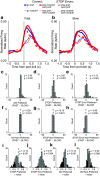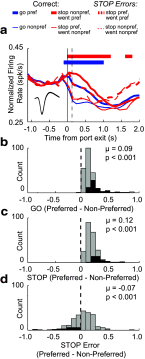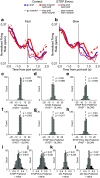Neural Signals in Red Nucleus during Reactive and Proactive Adjustments in Behavior
- PMID: 32376779
- PMCID: PMC7294803
- DOI: 10.1523/JNEUROSCI.2775-19.2020
Neural Signals in Red Nucleus during Reactive and Proactive Adjustments in Behavior
Abstract
The ability to adjust behavior is an essential component of cognitive control. Much is known about frontal and striatal processes that support cognitive control, but few studies have investigated how motor signals change during reactive and proactive adjustments in motor output. To address this, we characterized neural signals in red nucleus (RN), a brain region linked to motor control, as male and female rats performed a novel variant of the stop-signal task. We found that activity in RN represented the direction of movement and was strongly correlated with movement speed. Additionally, we found that directional movement signals were amplified on STOP trials before completion of the response and that the strength of RN signals was modulated when rats exhibited cognitive control. These results provide the first evidence that neural signals in RN integrate cognitive control signals to reshape motor outcomes reactively within trials and proactivity across them.SIGNIFICANCE STATEMENT Healthy human behavior requires the suppression or inhibition of errant or maladaptive motor responses, often called cognitive control. While much is known about how frontal brain regions facilitate cognitive control, less is known about how motor regions respond to rapid and unexpected changes in action selection. To address this, we recorded from neurons in the red nucleus, a motor region thought to be important for initiating movement in rats performing a cognitive control task. We show that red nucleus tracks motor plans and that selectivity was modulated on trials that required shifting from one motor response to another. Collectively, these findings suggest that red nucleus contributes to modulating motor behavior during cognitive control.
Keywords: cognitive control; inhibition; motor; red nucleus; single-neuron recording; stop signal.
Copyright © 2020 Brockett et al.
Figures









Similar articles
-
Distinct Action Signals by Subregions in the Nucleus Accumbens during STOP-Change Performance.J Neurosci. 2024 Jul 17;44(29):e0020242024. doi: 10.1523/JNEUROSCI.0020-24.2024. J Neurosci. 2024. PMID: 38897724 Free PMC article.
-
Supplementary motor area exerts proactive and reactive control of arm movements.J Neurosci. 2010 Nov 3;30(44):14657-75. doi: 10.1523/JNEUROSCI.2669-10.2010. J Neurosci. 2010. PMID: 21048123 Free PMC article.
-
Executive control signals in orbitofrontal cortex during response inhibition.J Neurosci. 2015 Mar 4;35(9):3903-14. doi: 10.1523/JNEUROSCI.3587-14.2015. J Neurosci. 2015. PMID: 25740519 Free PMC article.
-
Neural mechanisms of movement planning: motor cortex and beyond.Curr Opin Neurobiol. 2018 Apr;49:33-41. doi: 10.1016/j.conb.2017.10.023. Epub 2017 Nov 21. Curr Opin Neurobiol. 2018. PMID: 29172091 Review.
-
From reactive to proactive and selective control: developing a richer model for stopping inappropriate responses.Biol Psychiatry. 2011 Jun 15;69(12):e55-68. doi: 10.1016/j.biopsych.2010.07.024. Epub 2010 Oct 8. Biol Psychiatry. 2011. PMID: 20932513 Free PMC article. Review.
Cited by
-
The zona incerta negatively regulates the red nucleus during movement cued by sound signals.PLoS Biol. 2025 Apr 7;23(4):e3003092. doi: 10.1371/journal.pbio.3003092. eCollection 2025 Apr. PLoS Biol. 2025. PMID: 40193390 Free PMC article.
-
The rodent medial prefrontal cortex and associated circuits in orchestrating adaptive behavior under variable demands.Neurosci Biobehav Rev. 2022 Apr;135:104569. doi: 10.1016/j.neubiorev.2022.104569. Epub 2022 Feb 4. Neurosci Biobehav Rev. 2022. PMID: 35131398 Free PMC article. Review.
-
The human brainstem's red nucleus was upgraded to support goal-directed action.Nat Commun. 2025 Apr 10;16(1):3398. doi: 10.1038/s41467-025-58172-z. Nat Commun. 2025. PMID: 40210909 Free PMC article.
-
Reactive and Proactive Adaptation of Cognitive and Motor Neural Signals during Performance of a Stop-Change Task.Brain Sci. 2021 May 11;11(5):617. doi: 10.3390/brainsci11050617. Brain Sci. 2021. PMID: 34064876 Free PMC article. Review.
-
Proactive Versus Reactive Control Strategies Differentially Mediate Alcohol Drinking in Male Wistars and P Rats.eNeuro. 2024 Mar 27;11(3):ENEURO.0385-23.2024. doi: 10.1523/ENEURO.0385-23.2024. Print 2024 Mar. eNeuro. 2024. PMID: 38423790 Free PMC article.
References
Publication types
MeSH terms
Grants and funding
LinkOut - more resources
Full Text Sources
